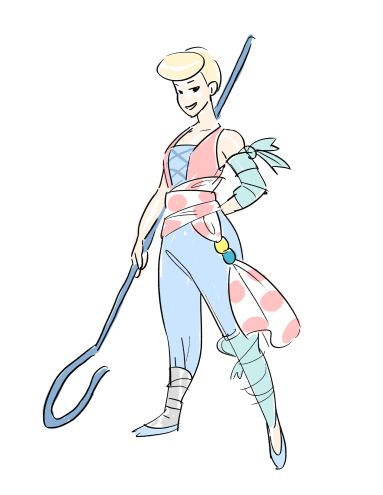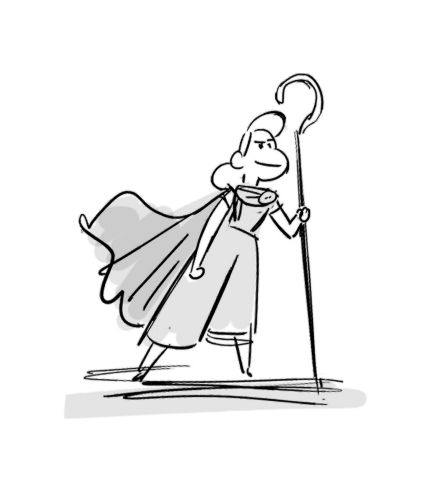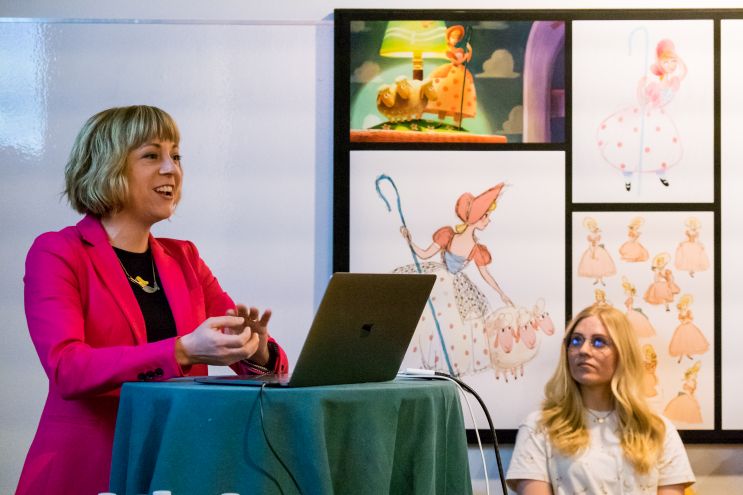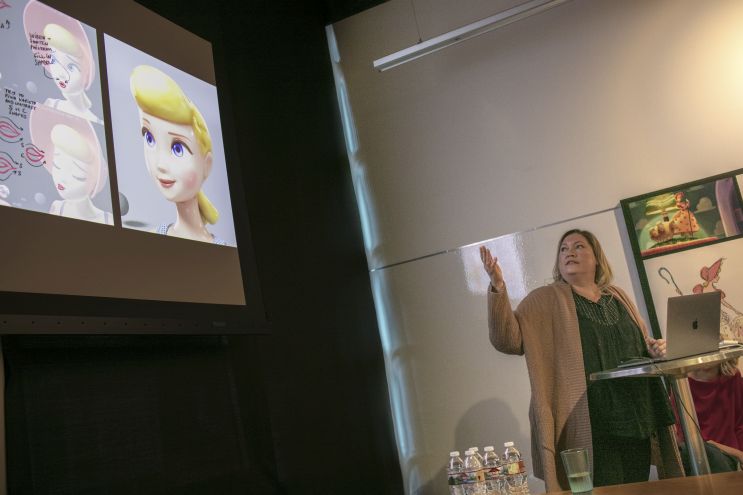Bo Peep Is Back. One of our favorite characters makes a return in Toy Story 4 and her character has evolved in many ways. Previously, Bo has been a supporting character, but for Toy Story 4, Bo becomes a lead and with that comes many changes. Bo was chipped and discarded over the years but her spirit is far from broken. She has become an adventure-seeking free spirit. She has become a leader, but in keeping with the reality of a battered survivor, fine details like small cracks in her porcelain glaze are showing. Since she’s always been out there in the rough-and-tumble world, not only has she gained more confidence, but she is also more resilient. She’s often the voice of reason.
Tanja Krampfert – a modeling artist for Bo Peep – explained that they had to create her from scratch. “We couldn’t use old assets to create her for Toy Story 4 because she was always a original background character.”
Patty Kihm, a directing animator explains that the essence of Bo has stayed the same, even as the team studied athletes and looked at various action movies to see how those movements of athleticism, dancing and stunts could lend themselves to animating a more energetic Bo Peep. They cataloged “a spice drawer of references to bring her to life.” Those references also solved questions about how to move Bo’s staff, which is an extension of her essence and who she is.
During the Pixar Press day, I sat down with Bo Peep’s Animating team, including Becki Tower, Mara MacMahon, and Carrie Hobson, to learn more about their first Toy Story memories and the way they brought Bo Peep back in 2019. The gallery is courtesy of Pixar Animations, providing an illustrated peek into the art and craft of her creation.
What’s your first memory of watching Toy Story?
Becki – I think I was in high school. I just remember not knowing 3D animation. I was such a big Disney buff in the traditional animation sense. It was the first time I saw 3D and thought, ‘a whole new world.’ I didn’t know it was possible, so for me, it was a sensory overload of a whole new art form.
Carrie – I remember feeling it was different. It felt more punty and fun.
When revisiting Bo, how has she changed and who she is now? What was it like for you as female animators to work on someone like her?
Mara: It excited me coming into the movie knowing this character was back. There’s the seed dropped in Toy Story 3 about toys being lost and I wondered what happened to her? I wanted to know. I was excited by the great potential for her. I think it was our obligation as filmmakers and storytellers to build her out as a character.
Becki – Commonly you see a female character on the arm of a male character or in conjunction with, so it was really nice to now have an opportunity to deep dive and to develop her as a character that could or couldn’t play against Woody. She was on her own and a comfortably lost toy. She had so much back story. I was excited to hear what happened to her, where we went and how she arrived here where we pick her up? That was totally separate to the life of the toys in Andy’s room or Bonnie’s room. That was exciting to know she had this rich history that we could celebrate outside of just her relationship with a male character.
What about in terms of the look, both technology has evolved since her last outing, but also who she is?
Becki: She is a beautiful model and a beautiful character. What Mara, Danielle and Tanja did was beautiful, but what I really like was never in film does she reference herself as a beautiful model. We see beauty come through in beauty and posture. The other characters are around her and we see how comfortable she is in her own skin. That’s very modern. She’s not taken for what she looks like as so much as who she is and who she has become. Again, there’s just so much depth. As a story team, we were working in the constraints of “here is a character who is pre-existing and she’s going to look a certain way.” She is a toy who was probably made in the 1950s? What’s the juxtaposition of that? How do you subvert that? She was made in the 1950s, but she’s still around in the present day. Just like real life what would her character arc have been? That was fun to dive into.
Did you go in and create a background story for her. So much could have happened in those years.
Mara – Oh yes. As animators, you’re always looking for more. You’re always wanting to know the why because it informs every acting choice, every story choice. It makes it more specific. At some point, we’re all getting on the same page about that back story. Whether you see it or not in the movie, we all have to communicate to each other, this is what this scene means to Bo.
When she finally opens up to him, this is what she means when she says that.
One thing I’ve learned about today is how collaborative this whole process is. Hearing everyone today, you’re the definition of collaboration. Describe the rinse and repeat?
Carrie: It’s so critical here because a good idea can come from anywhere and anyone. It’s how you utilize it and how you constantly keep that line of communication and willingness to be open to an idea. It’s very easy to be set in ways, but for Bo, we met once a week and discuss where she’s at. At one point, we talked about settling on the design.
Patty brought up the cape. If we were going to do it, every scene should reflect her mood and whether she’s being closed off or open. We put that in the boards.
Becki: Again, it’s just seeds of ideas. You have to create a through-line to keep the art, the model, the story and the animated intent. It’s hard to put that all on one person – the director. So, for all of us to hold hands and pass this information and be guardians over our own department and how Bo gets translated is such a win. When you have a scene where Bo’s emotional state is changing and to have a moment where it would be a great time to pull her cape shut, that started months ago over a coffee conversation and is now in the film because we’re being guardians over that information and those ideas. We’re empowering the entire team to consider thoughts and important details from long ago.
Annie Potts is back voicing Bo. How does she influence the animation and the characters herself?
Carrie: She’s got a very specific voice that I love. It was really fun. We pitched this new version of Bo to her. She got really excited. I was great to see a positive reaction for her. At one point, I did scratch for her and it just didn’t feel right. We had other people do scratch for her, but it didn’t feel like Bo. What Annie brings to the table is she has a maturity to her voice and it’s not often times heard.
Becki: They videotape her as she does her recording and it’s great for us to pull that up. We don’t copy the actor or actress. There’s one scene that is emotionally heavy. The animator had the reference up and she did this great eye movement where she looks up and looks away. It felt so authentic and genuine. I thought it was a great conversation starter about that choice. Was it her choice or her instinct to do that? It empowers us to deep dive into that exact decision. Does it work for Bo? Does it not work? It’s such an educational opportunity for everybody.
Bo does a lot more action moves in Toy Story 4. You watched Olympic footage for inspiration, what else helped animate those sequences?
Becki: We see her scale big furniture things and how you could have a porcelain doll feel small but again protective. So, it was really influential to watch strong and competent female athletes on balance beams and parallel bars. That stuff is awesome to explore.
There’s one shot where she’s hanging from a rope and hangs from a piece of furniture. We animated that a few different times because we asked ourselves, how would she protect her body more. We tried different poses and different timings. We had to keep referencing that she understood that she was porcelain and that she would instinctually brace this way.
How many porcelain dolls did you study and look at?
Mara: Art did extensive research. At one point, I went over and they had bins of porcelain dolls.
What does Bo represent?
Mara: She is whatever toy she wants to be within her constraints. She represents this beautiful idea that you can’t change the cards that you get in life, but you can control how you play them.
Toy Story 4 is released on June 21



























![2025 Oscars: Can a Late-Breaker Still Win Best Picture? [POLL]](https://www.awardsdaily.com/wp-content/uploads/2024/10/gladiator-350x250.jpg)
